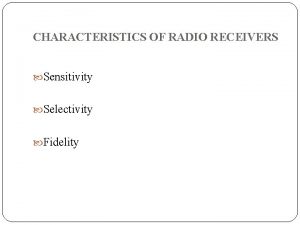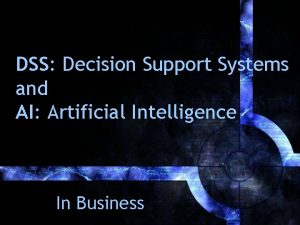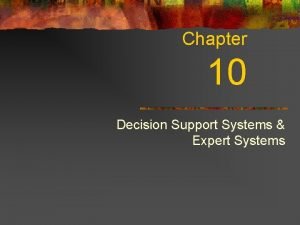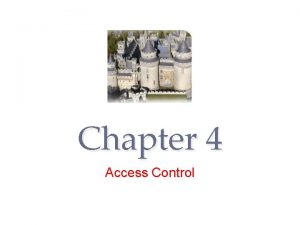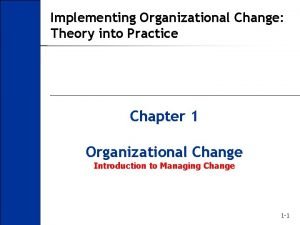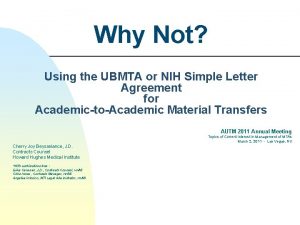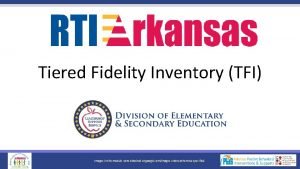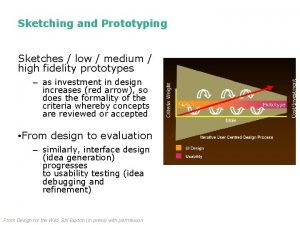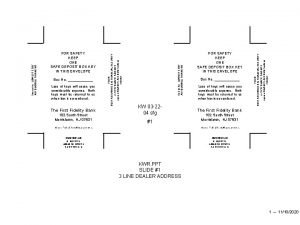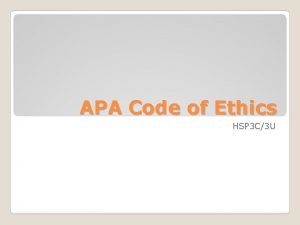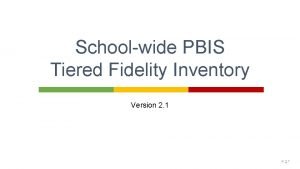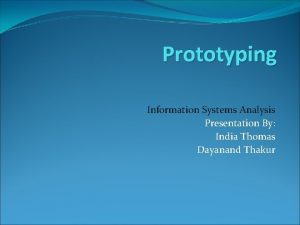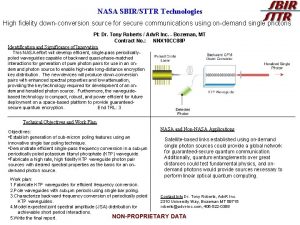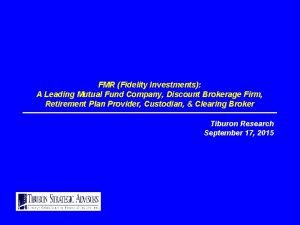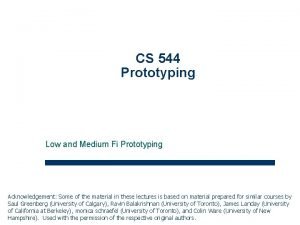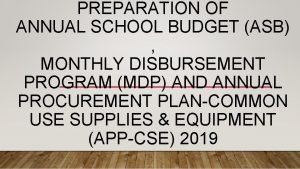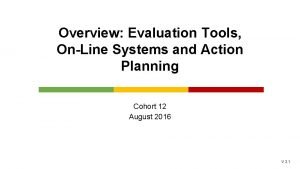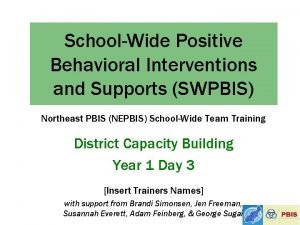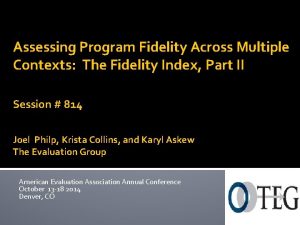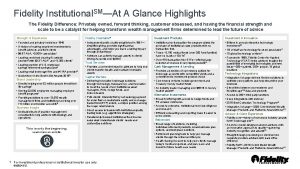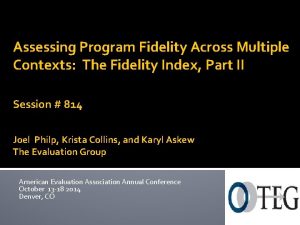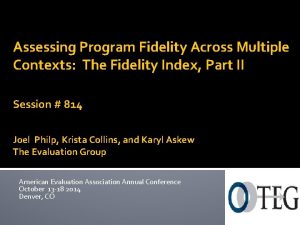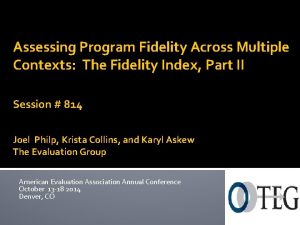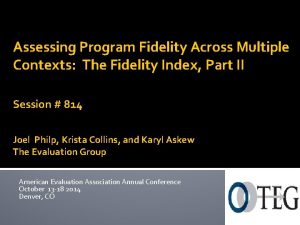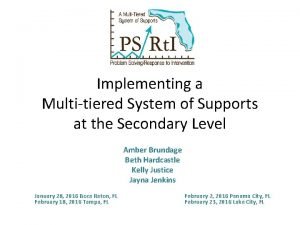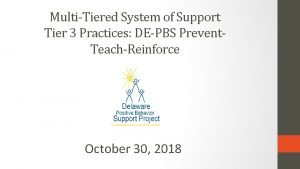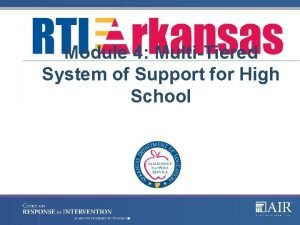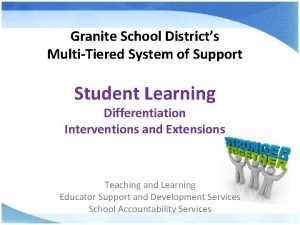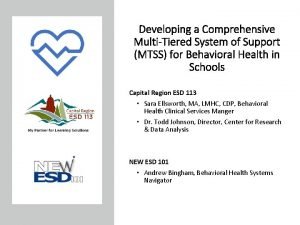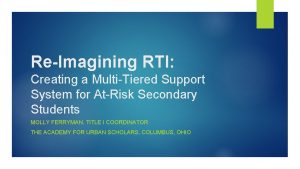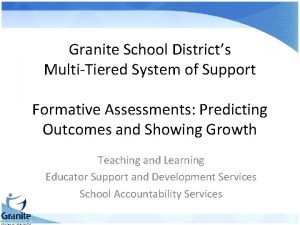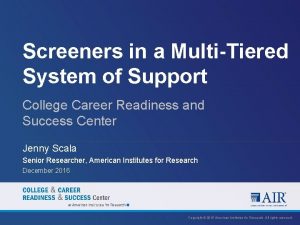Implementing the Multitiered System of Support with Fidelity
























































- Slides: 56

Implementing the Multitiered System of Support with Fidelity Winsome Waite, Ph. D. Laura Magnuson M. Ed. Presented on behalf of the North Dakota Department of Public Instruction

In this webinar… § What is the Multi-tiered System of Support? § Tier I • Implementing Primary Tier with Fidelity § Tier II • Implementing Secondary Tier with Fidelity § Tier III • Implementing Tertiary Tier with Fidelity 2

What is the Multi-tiered System of Support (MTSS)? 3

Essential Components of RTI Tier II Tier I 4

Multi-tiered System of Support Tier III Tier II (~ 5 % of students) (~15% of students) Tier I FRAMEWORK 3 levels of intensity: • Primary or Tier 1 • Secondary or Tier II • Tertiary or Tier III (~80% of students) 5

Multi-tiered System of Support Tier III Tier II Multiple strategies and interventions are provided at each tier Tier I 6

RTI Center recommends different evidence standards across intervention tiers. Research-based curricula • Recommended for tier I across subjects. • Components have been researched and found to be generally effective. • Curriculum materials have not been rigorously evaluated as a package. Evidence-based intervention • Recommended for tier II and, adapted at tier III. • Materials evaluated using rigorous research design. • Evidence of positive response for students who received the intervention. (NCRTI, 2010) 7

Tier I 8

Primary Instruction § FOCUS: ALL students § INSTRUCTION: District curriculum and instructional practices that are research based; aligned with state or district standards; and incorporate differentiated instruction and flexible grouping 9

Primary Instruction § SETTING: General education setting § ASSESSMENTS: Screening, continuous progress monitoring, and outcome measures or summative assessments 10

What Is Primary/Core Curriculum in RTI? § Course of study (skills, concepts) deemed critical § What we want students to know; not where or how we teach students § Usually mandatory for all students of a school or a school system 11

Common Core State Standards and Alignment to RTI 12

Differentiated Learning Activities in Core Instruction § Offers students in the same class different teaching and learning strategies based on: • • Student assessment data Knowledge of student readiness Learning preferences Language and culture 13

What Are Differentiated Learning Activities? § Involves • • • Mixed instructional groupings, Team teaching, Peer tutoring, Learning centers, and Accommodations to ensure that all students have access to the instructional program § Is NOT the same as providing more intensive interventions to students with learning disabilities 14

Important Assessments at Tier I § Screening data • Identify students who need additional assessment or instruction. • Evaluate the effectiveness of primary prevention for all students. § Progress monitoring data • Confirm and disconfirm risk. 15

Implementing Tier I with Fidelity 16

Fidelity at the Primary Level 17

Indicators of Fidelity at Tier I üResearch-Based Curriculum Materials üFidelity üArticulation of Teaching and Learning (in and across grade levels) üInstruction üSchool-Based Professional Development 18

Example: Instruction § A score of “ 5” means: § What questions could you ask to determine a school/district’s score? § What evidence could be collected? Both conditions are met: (1) Most or all teachers differentiate instruction; (2) teachers use students’ assessment data to identify the needs of students. 19

Tier II 20

Secondary Interventions § FOCUS: Students identified through screening as at risk for poor learning outcomes § INSTRUCTION: Targeted, supplemental instruction delivered to small groups 21

Secondary Interventions § SETTING: Regular education classroom or other regular education location within the school § ASSESSMENTS: Progress monitoring, diagnostic 22

Instruction at Tier II § Staff members use to clearly articulated, validated evidence-based interventions that are aligned with the core curriculum – Explicitly follow evidence-based program as it was designed – High-quality instruction 23

Instruction at Tier II § Staff members implement intervention based on the duration and time frame defined by the program developer. For example: provide 30 minutes of reading instruction per day, three to five days per week in addition to core. 24

Instruction at Tier II § The group size is optimal (according to research) for the age and needs of students § Students are engaged throughout interventions 25

Important Tier II Assessments § Progress monitoring • • • Monitor student response to secondary instruction. Evaluate the efficacy of the secondary system. Conduct at least monthly. § Diagnostic assessment • Match students’ needs to interventions. 26

Tier II Decision-Making § Decisions about responsiveness to intervention § Are based on reliable and valid progress monitoring data. § Reflect judgment based on the slope of improvement or final status at the end of the intervention period. § Decision-making rules are applied accurately and consistently 27

Tier II Decision-Making: Goal Setting methods: § End-of-year benchmarking § National norms for weekly rate of improvement (slope) 28

Setting Goals With End-of-Year Benchmarking (Example) Grade Reading Task Computation Concepts and Applications — — Kindergarten 40 sounds/min (Letter Sound Fluency) Grade 1 60 words/min (Word Id Fluency) 20 digits 20 points Grade 2 75 words/min (Passage Reading Fluency) 20 digits 20 points Grade 3 100 words/min (PRF) 30 digits 30 points Grade 4 20 replacements/2. 5 min (Maze) 40 digits 30 points Grade 5 25 replacements/2. 5 min (Maze) 30 digits 15 points Grade 6 30 replacements/2. 5 min (Maze) 35 digits 15 points Note: These figures may change pending additional RTI research. 29

Setting Goals with End-of. Year Benchmarking end-of-year benchmark goal line X X 30

Setting Goals With National Norms for Weekly Improvement (slope) Grade Reading— Slope Computation CBM—Slope for Digits Correct Concepts and Applications CBM— Slope for Points 1 1. 8 (WIF) . 35 No data available 2 1. 5 (PRF) . 30 . 40 3 1. 0 (PRF) . 30 . 60 4 . 40 (Maze) . 70 5 . 40 (Maze) . 70 6 . 40 (Maze) . 40 . 70 Note: These figures may change pending additional RTI research and are specific to a certain tool. 31

Setting Goals With National Norms for Weekly Improvement (slope) Standard Formula for Calculating Goal Using Rate of Improvement (ROI): ROI x # Weeks + Baseline Score = GOAL 32

Tier II Decision-Making: Decision Rules § Determine response to secondary interventions using • The four-point rule. • Trend-line analysis. • Compare efficacy of secondary interventions. 33

Progress Monitoring: Determining Response Using the Four-Point Rule X X Goal line 34

Progress Monitoring: Determining Response Using Trend Line Analysis Trend line X X Goal line 35

Implementing Tier II with Fidelity 36

37

Indicators of Fidelity at Tier II üEvidence-Based Intervention üComplements Core Instruction üFidelity üInstruction üDetermining Responsiveness to Tier II üAddition to Primary 38

Example: Determining Responsiveness to Secondary Level Prevention § A score of “ 5” means: § What questions could you ask to determine a school/district’s score? § What evidence could be collected? Both conditions are met: (1) Decisions about responsiveness to intervention are based on reliable and valid progress monitoring data to reflect slope of improvement or final status at the end of secondary level prevention; (2) these decision making criteria are implemented accurately. 39

Tier III 40

Tertiary Interventions § FOCUS: Students who have not responded to primary or secondary instruction § INSTRUCTION: Intensive, supplemental instruction delivered to small groups or individually 41

Tertiary Interventions § SETTING: General or special educator setting (depending on needs of the student) § ASSESSMENTS: Progress monitoring, diagnostic 42

Instruction at Tier III § Start with evidence-based Tier II intervention and deliver with greater intensity. • Quantitative adaptations • Qualitative adaptations § Conduct and use student progress monitoring and diagnostic data to intensify and individualize intervention. § Ensure the process is recursive and ongoing. 43

Changing the Intensity and Nature of Instruction § Quantitative changes • • Duration Frequency Interventionist Group size 44

Changing the Intensity and Nature of Instruction § Qualitative changes: • Alter instruction based on learner characteristics (e. g. , addressing working memory or attention problems) • Change content delivery method • Change how students respond • Increase the amount of adult feedback and error correction students receive • Increase frequency/specificity of checks for retention • The materials, curriculum, or whole intervention 45

Important Tier III Assessments § Progress monitoring • Frequent progress monitoring (weekly) is recommended. • Continuously monitor progress based on established learning trajectories indicated by the goal line. § Diagnostic • Match instruction to needs. • Inform individualized instructional planning. 46

Tier III Decision-Making § Decisions about responsiveness to intervention • Are based on reliable and valid progress monitoring data. • Reflect judgment based on the slope of improvement or final status at the end of the intervention period. § Decision-making rules are in place and applied accurately. 47

Tier III Decision-Making: Goal Setting § End-of-year benchmarking § National norms for weekly rate of improvement (slope) § Intra-individual 48

Setting Goals With Intra. Individual Framework Intra-individual goal setting method: § Identify weekly rate of improvement (slope) using at least eight data points § Multiply slope by 1. 5 § Multiply by number of weeks until end of year § Add to student’s baseline score § This is the end-of-year goal 49

Tier III Decision-Making: Decision Rules § Determine response to secondary interventions using • The four-point rule. • Trend line analysis and slope. 50

Implementing Tier III with Fidelity 51

52

Indicators of Fidelity at Tier III üEvidence-Based Intervention üFidelity üInstruction üDetermining Responsiveness to Tier III üRelationship to Primary 53

Example: Evidence-Based Intervention § A score of “ 5” means: § What questions could you ask to determine a school/district’s score? § What evidence could be collected? Both conditions are met: (1)Tertiary level interventions are evidence-based standard protocols or based on validated progress monitoring methods for individualizing instruction; (2) tertiary interventions are more intensive than secondary interventions. 54

For More Information… § Follow the ND DPI for information about other webinars that are part of this series: üImplementing Response to Intervention with Fidelity üImplementing Screening with Fidelity üImplementing Progress Monitoring with Fidelity 55

Thank You Email: wwaite@air. org lmagnuson@air. org 1000 Thomas Jefferson Street NW Washington, DC 20007 -3835 202 -403 -5000 TTY: 877 -334 -3499 www. rti 4 success. org, www. intensiveintervention. org, www. air. org 56
 Selectivity in analog communication
Selectivity in analog communication Grammatical signals
Grammatical signals Expert system vs decision support system
Expert system vs decision support system Difference between dss and expert system
Difference between dss and expert system Decision categories
Decision categories Implementing hrd programs
Implementing hrd programs Management issues central to strategy implementation
Management issues central to strategy implementation Implementing strategies: management and operations issues
Implementing strategies: management and operations issues Chapter 7 strategic management
Chapter 7 strategic management Setting prices and implementing revenue management
Setting prices and implementing revenue management Implementing merchandise plans
Implementing merchandise plans Toyota brand hierarchy
Toyota brand hierarchy Designing and implementing branding strategies
Designing and implementing branding strategies Stages in implementing portfolio assessment
Stages in implementing portfolio assessment Crm project plan
Crm project plan Qsen teamwork and collaboration definition
Qsen teamwork and collaboration definition Challenges of implementing predictive analytics
Challenges of implementing predictive analytics Implementing organizational change spector
Implementing organizational change spector Finance and accounting issues in strategy implementation
Finance and accounting issues in strategy implementation Access rights definition
Access rights definition Keys to successful project portfolio management
Keys to successful project portfolio management Implementing strategies management and operations issues
Implementing strategies management and operations issues Nivea brand architecture
Nivea brand architecture Nfpa 1600 standard
Nfpa 1600 standard Implementing organizational change theory into practice
Implementing organizational change theory into practice Ubmta implementing letter
Ubmta implementing letter Emap
Emap Zpf cisco
Zpf cisco Implementing strategies management and operations issues
Implementing strategies management and operations issues Fidelity advisor 529 plan
Fidelity advisor 529 plan Clickable prototype
Clickable prototype Narrative coherence and fidelity examples
Narrative coherence and fidelity examples Color 2132002
Color 2132002 Fidelity fiduciary services
Fidelity fiduciary services Variable length coding in digital image processing
Variable length coding in digital image processing Tiered fidelity inventory worksheet
Tiered fidelity inventory worksheet Low medium high fidelity prototypes
Low medium high fidelity prototypes Fidelity in confucianism
Fidelity in confucianism Fidelity ethical principle
Fidelity ethical principle Fidelity morristown
Fidelity morristown Narrative coherence and fidelity examples
Narrative coherence and fidelity examples Fidelity and responsibility apa
Fidelity and responsibility apa Tiered fidelity inventory
Tiered fidelity inventory Disadvantages of low fidelity prototype
Disadvantages of low fidelity prototype High fidelity property management
High fidelity property management Fmr asset management
Fmr asset management Bluetooth etymology
Bluetooth etymology Storyboard/low fidelity prototype
Storyboard/low fidelity prototype Housing services
Housing services Jusan call center
Jusan call center Fidelity bond deped
Fidelity bond deped Swpbis tiered fidelity inventory
Swpbis tiered fidelity inventory Fidelity quarterly market update q1 2018
Fidelity quarterly market update q1 2018 Hamid rahim
Hamid rahim Fidelity telemarketing
Fidelity telemarketing Fidelity connect
Fidelity connect G team
G team
